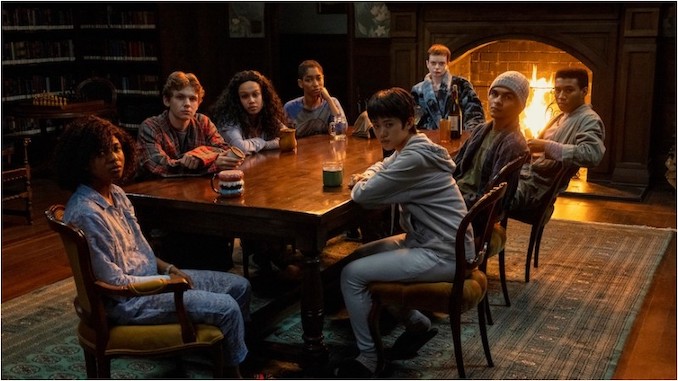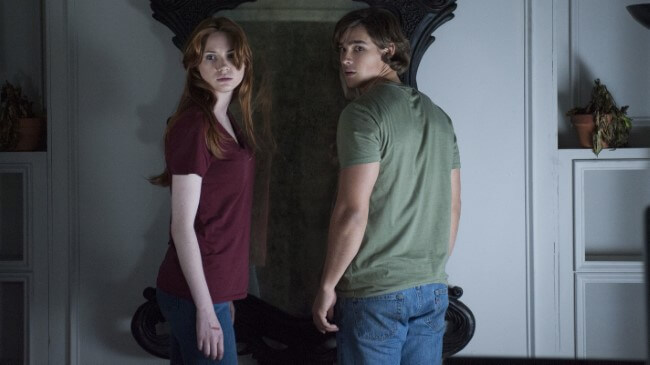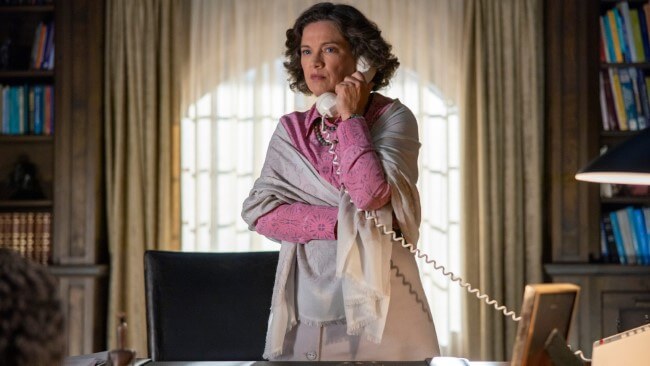The Midnight Club Showcases the Best and Worst of Mike Flanagan’s Narrative Obsessions
Photo Courtesy of Netflix TV Features Netflix
Netflix’s The Midnight Club is the streamer’s fourth TV series collaboration with writer-director Mike Flanagan, with whom the network has now cemented such a relationship that they’ve dubbed their collection of his series and movies as the “Flanaverse.” It follows the likes of The Haunting of Hill House, The Haunting of Bly Manor, and Midnight Mass as another exploration of several Flanagan trademarks—heavy emotion and sentimentality within a horror space, tinged with supernatural menace—while, for the first time being framed in more of a YA perspective thanks to its cast of terminal, teenage protagonists taking solace in the community of their supportive hospice.
For the first time, however, Flanagan has crafted a story in The Midnight Club that wasn’t intended to tidily conclude within the boundaries of a single season. Rather, the story was conceived with at least two seasons in mind, though it hasn’t yet been formally renewed by Netflix—troubling, in the same sense that the likes of The Sandman STILL hasn’t been renewed. It would seem that The Midnight Club and its fate, secrets and revelations have been left to the streamer’s whims, though Flanagan has at least promised he’ll provide answers via Twitter of all places, if a second season is never produced.
That uncertainty, however, obscures the point we should be talking about in this moment, which is the way The Midnight Club both celebrates Flanagan’s greatest strengths as a writer and stylist, but also highlights the most damaging aspects of his sometimes self-indulgent style. Without even a little bit of closure and finality in its first season, The Midnight Club concludes in rather frustrating fashion, consistently raising new questions in an effort to keep viewers coming back, while simultaneously struggling to justify a 10-hour runtime in telling a central storyline that is often rendered motionless for an hour or more at a time. Of all the Flanagan projects for Netflix, in fact, this one feels the least like a story that requires a second season to tell, and I can’t help but wonder how much tighter, more streamlined (and satisfying) it might have been if it had been written from the start with only one season in mind. Perhaps we’d all be clamoring about Midnight Club as a masterpiece right now, if that had been the case.
Rest assured, I’ve been a fan of Mike Flanagan’s work for a long time at this point, since well before the director’s name was widely associated with critical acclaim. From the moment I saw Oculus in 2013, I was an instant admirer—he took a basic premise that could have been rendered as a trite, toothless, PG-13 horror potboiler about a haunted mirror and instead turned it into a much more complex and ambitious story about the nature of time, vengeance and the soul. For years afterward, I evangelized about Oculus to friends, describing the film as more than meets the eye, an intelligent horror feature with great performances and surprisingly metaphysical evolution to its narrative. I also dove readily into Flanagan’s wonderfully imaginative directorial debut Absentia from 2011, somewhat held back by a miniscule budget, but it was satisfying to watch some of those same talents and tricks utilized in increasingly polished feature films to come, from Hush to Doctor Sleep.
 Oculus is still a film that any fan of Flanagan’s TV shows should make time to watch.
Oculus is still a film that any fan of Flanagan’s TV shows should make time to watch.
Watch enough of Flanagan’s work, though, across both film and streaming TV series, and you begin to get a sense of the persistent narrative themes that drive him; ideas he can’t quite seem to let go of or escape. Perhaps chief among them is his fascination with the flow of time, and stories about locations where important events happened in the same physical space, but at different points in time. Many of the director’s biggest hits, the projects with which we was most intimately associated as a writer, repeat this focus on time and temporal displacement. Oculus was set in a house where the past and present begin to collide. The Haunting of Hill House is largely based around a titular house where almost the same thing ultimately happens. So is Bly Manor. And so is The Midnight Club once again, as events at the hospice from at least four different time periods appear to be of paramount importance, and protagonist Ilonka occasionally finds herself thrust into scenes out of the past. This kind of scene has become a Flanagan staple, now bordering on cliche.
These types of sequences in Flanagan’s work speak to his desire to tell stories that are more complex under the surface than they initially appear to be—he seems to love the idea of cyclical events, in which the present and past are essentially occurring simultaneously, perhaps influencing each other rather than being a linear flow. And this convention works well in the likes of Oculus and The Haunting of Hill House because the narrative has enough momentum and plot development to carry the viewer all the way to their eventual revelations in a timely manner. The result is exciting; there are few moments where it feels like the narrative is spinning its wheels.
The Midnight Club, on the other hand, seems to want to return to some of these themes, but the multiple season structure is requiring the narrative to unfold over a decidedly slower pace. In the process, that momentum is being lost, and I worry that the series could simply topple and fall over, like a bicyclist trying to pedal slowly uphill. This narrative is being powered by the smallest possible units of plot development, attempting to substitute character development in its place. And at that point, one runs into the criticism that has typified Flanagan’s last few Netflix outings, which boils down to self-indulgent moralizing, speechifying, and protagonists whose encyclopedic philosophical alertness begins to render them as unrealistic and inaccessible to viewers.
It should go without saying that plot isn’t everything, when it comes to a series. And indeed, too many viewers have a tendency to get overly focused on the importance of plot, to the detriment of mood and subtext. Mike Flanagan is a writer who inherently gets mood and subtext. But Midnight Club increasingly seems to take the minimization of plot to extremes, particularly in the back half of its first season. There are times when it feels like it wants to immerse itself in anything BUT its central mysteries, and it becomes increasingly difficult to engage with aspects such as the titular club’s storytelling when what the viewer really wants is more exploration of the mysteries at the heart of Brightcliffe. As you watch, you ache for the characters to ask questions, to engage with the plot, but instead each episode largely concerns itself with the minutia of their interpersonal relationships. These scenes are skillfully handled, and the performers are all inherently likable, but over the course of the full season the overall effect comes to feel like the supernatural story of what may or may not be happening at Brightcliffe is always being held at arm’s reach. It’s as if The Midnight Club is hunting for diversions, distractions to keep the audience busy for long enough to fill out each episode, until it dangles the carrot of plot advancement in the closing moments. When the finale ends with yet another newly raised mystery surrounding Dr. Stanton, it seems to promise “Come back for Season 2, and I’ll totally make it worth your while.”
 I rather wonder if even Heather Langenkamp knows what’s going on with her character.
I rather wonder if even Heather Langenkamp knows what’s going on with her character.
Suffice to say, this makes for some frustrating episodes, and it hurts the audience’s ability to really appreciate the things that The Midnight Club is simultaneously doing well. In particular, the stories-within-a-story that the kids tell around the fireplace in Brightcliffe’s library are lovingly rendered, and a great excuse to let the actors stretch their legs and portray different character archetypes, but it simultaneously feels like they often occupy too big a percentage of any given Midnight Club episode. Or perhaps it only feels that way because we like these characters, and we want to know whether they’re really experiencing paranormal events in their quiet moments in the Brightcliffe halls. As much as I’d like to focus on Sharon’s detective noir, or Spencer’s Terminator-inspired sci-fi story, I can’t tear my awareness away from the fact that time is running out on each given episode, without the audience being any closer to understanding Brightcliffe’s elderly ghosts, or the machinations of The Paragon, the former cult that operated on the grounds.
You can certainly argue that this withholding of answers and plot development is itself a theme of The Midnight Club, because this is a story about desperate young people who so often want to believe in placebos and magical thinking—we don’t know whether the witchy ritual they engage in actually has any true effect at the season’s end, which mirrors the frustration they feel in not knowing whether treatment (either scientific or mystical) is working. I can admit that makes its own sort of sense. Where the viewer is likely to object is in response to the content we’re given instead of exploration of those answers, which all too often boils down to long, philosophically inclined conversations that feel designed to haughtily show off the characters’ compassion and intelligence. How can you write a back-and-forth between a teenager and a janitor that includes FOUR quotes from Friedrich Nietzsche, Ralph Waldo Emerson and John Lennon in the span of two minutes, and not expect it to come off as at least a little pretentious?
There are myriad individual questions one could ask about the series at this point, from “Why does Ilonka have psychic premonitions about Brightcliffe in the first episode, but never display any ability like that again?” to “How are the elderly ghosts of the house’s original residents related to the cult, and why can only Ilonka and Kevin see them?” Diving directly into those questions now, though, in the wake of Midnight Club’s first season, doesn’t really accomplish anything, because there are no answers to be mined from the ether. Perhaps if the series had thrown us more of a bone in its first season finale—clarified Stanton’s background, or the relationship between Julia Jayne and Stanton—it would be easier to put the other questions aside. As is, however, it feels like Mike Flanagan’s house style is being stretched by this format, possibly to its breaking point, which has the unfortunate effect of highlighting the director’s indulgences more than his strengths.
Perhaps when all is said and done, and assuming the series does indeed get a second season, Flanagan will tie The Midnight Club together with a bow so impressive that it will add consequence and richness to all those scenes in the first season that feel more or less like stalling for time. Maybe even the Ralph Waldo Emerson quotes will loom large, in the end. But to tell the truth, that just feels like more magical thinking to me.
Jim Vorel is a Paste Magazine staff writer and resident horror buff. You can follow him on Twitter for more film writing.
For all the latest TV news, reviews, lists and features, follow @Paste_TV.